The oldest university in New York and the fifth oldest in the United States, Columbia University was founded as an Anglican institution in 1754.
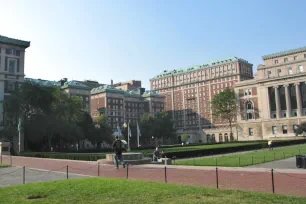
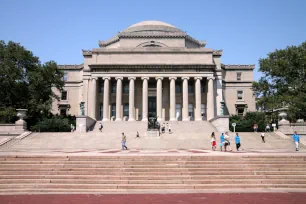
Established by a charter issued by King George I, the university was first known as King’s College and thirty years later – after the American Revolution – changed its name to Columbia, the personification of the United States of America.
The Campus of Columbia University
Columbia has occupied its current site in Manhattan’s Morningside Heights district since 1897. The president at that time, Seth Low, hoped that the move uptown would give the university more room to expand.
The famous architectural firms of McKim, Mead, and White were chosen to design the new campus. Charles McKim modeled it after the Athenian agora and Columbia remains the largest collection of McKim, Mead, and White buildings in the world.
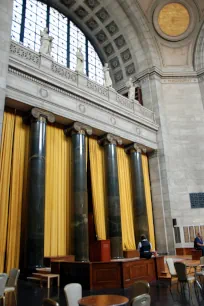
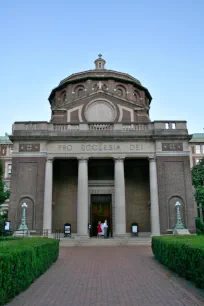
Buildings
Low Memorial Library
The campus features many architectural masterpieces, not the least of which is the Low Memorial Library, which most people consider to be the centerpiece of the campus. Currently housing the visitor’s center and many of the college’s administration offices, the Low Library was built in the Roman Classical style.
It’s a popular gathering space for students, and some have described it as an “urban beach”, where students enjoy socializing and sunbathing on warm days. The former library is a National Historic Landmark, as is nearby Pupin Hall, site of much ground-breaking atomic research.
St. Paul’s Chapel
St. Paul’s Chapel, built in 1904, was the first building on the campus not designed by the famous architectural firm. The Northern Italian Renaissance Revival Building is faced with burned brick, limestone, and marble trim, while the tiled roof is crowned with a small cupola. It’s a designated NYC landmark. Don’t miss the George Nakashima-designed Peace Altar inside the chapel.
More Buildings
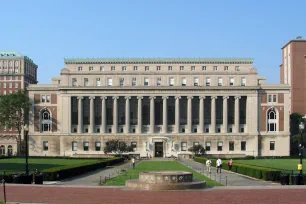
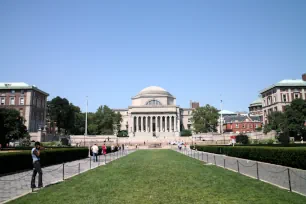
Other newer but equally impressive buildings include the Sherman Fairchild Center for the Life Sciences and the Morris A. Schapiro Center for Engineering and Physical Science Research. The former, a seven-story building, houses the Department of Biological Sciences. The Schapiro Center reflects the nineteenth-century styling of the campus but contains a number of more contemporary elements as well, including the liberal use of metal and ceramic-patterned glass.
Jerome L. Green Hall, the main building for the Law School, is also quite wonderful. It was designed by Max Abramovitz, one of the architects who designed the United Nations Headquarters. Also check out Butler Library, Alfred Lerner Hall, and Earl Hall, another one of the oldest buildings on campus.
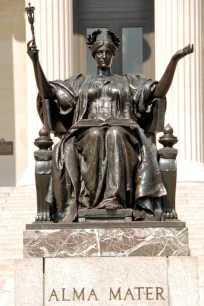
Monuments
On the broad flight of steps that lead to the Low Library stands a large bronze statue called «Alma Mater». It was created in 1901 and formally unveiled here in 1903. The sculptor was Daniel Chester French, who is best known for creating the statue of Lincoln at the Lincoln Memorial in Washington, DC.
Alma Mater is Latin for “Nourishing Mother”, a term which can be traced back to the University of Bologna, Italy – the oldest university in the world – whose motto is “Alma Mater Studiorum” (Nourishing Mother of Studies). Today, it is a term used to refer to the university that one formerly attended.
The mascot of Columbia University is a lion, which explains the large bronze lion statue that stands in front of the Mathematics and Havemeyer Halls. The statue – known as «Scholars’ Lion» – was created in 2004 by alumnus Greg Wyatt, the sculptor-in-residence at the nearby Cathedral Church of St. John the Divine.
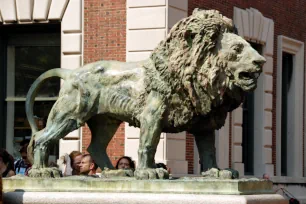
On the lawn behind St. Paul’s Chapel sits a cast of «The Thinker» that was installed here in 1931. This is one of 27 full-scale castings that were made of Auguste Rodin’s most famous work.
Near Lewisohn Hall rests the figure of Pan, an ancient Greek god who is partly goat – partly human in appearance. The bronze statue, known as «The Great God Pan», was created by George Grey Barnard in 1899. It was originally intended to be part of a fountain for The Dakota, but was donated, first to Central Park, and later to Columbia University, where it was installed in 1907.
Other sculptures include statues featuring prominent Americans such as the statue of Alexander Hamilton, Columbia University’s most famous alumnus, which stands appropriately enough in front of Hamilton Hall. The statue was created in 1908 by yet another alumnus of the university: William Ordway Partridge. Six years later, the same architect created the statue of Thomas Jefferson that stands near the School of Journalism.
There are also several modern sculptures on the grounds of Columbia University, including «The Curl», an abstract piece by Clement Meadmore from 1968; and «Three Way Piece No.1: Points», a sculpture by Henry Moore from 1967.
- Next: Union Square
- More Sights & Attractions in New York

